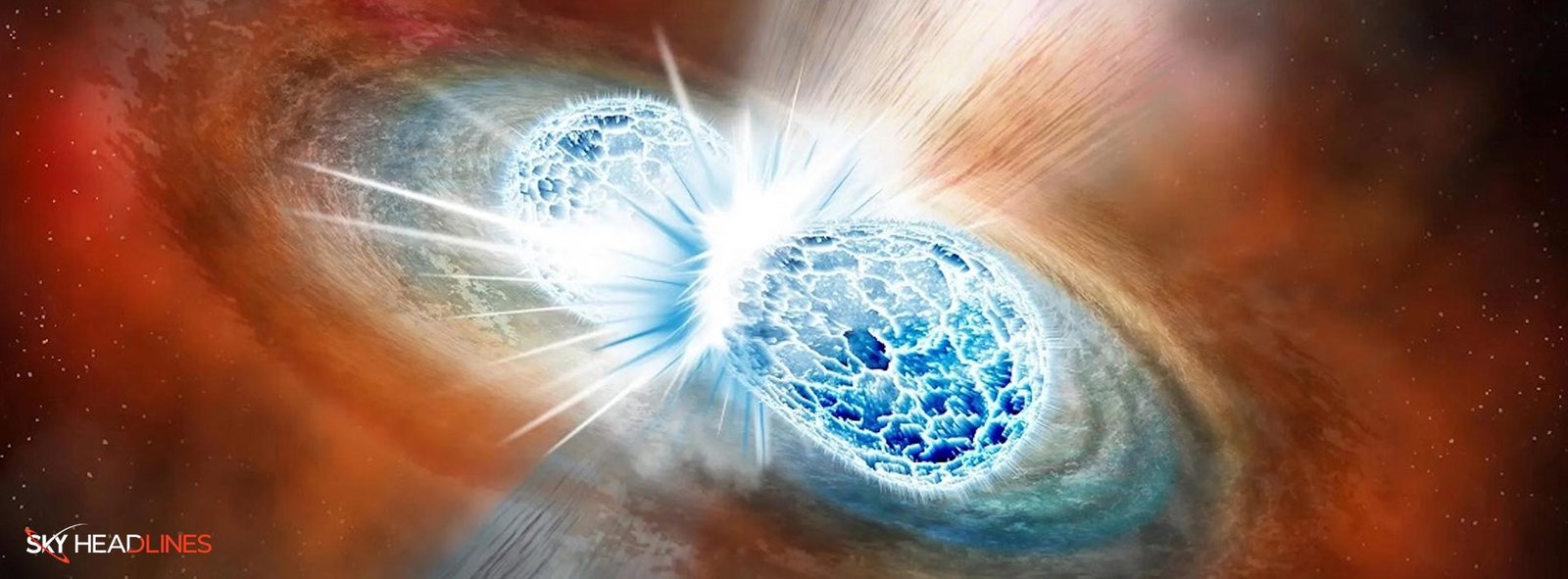When neutron stars meet, they cause Kilonova explosions, but they’re not as disruptive as you might think. A recent study indicates that when neutron stars collide, the resulting explosions are exactly spherical.
This goes opposite to the current thinking that these explosions, known as kilonovas, should move in the form of flattened discs. The round shape of these explosions, however, remains a mystery.
As metals like gold, platinum, and uranium are only formed in the severe conditions created by these gigantic cosmic explosions, kilonova are crucial to our knowledge of cosmic evolution.
A black hole is formed by the rapid collapse of a combined neutron star at the end of a kilonova. Any knowledge on the collisions that trigger these occurrences is like gold dust to astrophysicists, but many other details about them remain mostly unknown.
Kilonova’s Spherical Shape!
In 2017, astronomers found the first ever kilonova, a cosmic explosion about 140 million light-years from Earth. Astrophysicists were shocked to learn that kilonovas are round after examining data from this big explosion.
Darach Watson, an associate professor at the Niels Bohr Institute in Copenhagen and a co-author of the paper, made a statement: “No one expected the explosion to look like this. It makes no sense that it is spherical, like a ball. But our calculations clearly show that it is,”.
Lead author and Niels Bohr Institute Ph.D. candidate Albert Sneppen elaborated on the study’s surprise finding that the 2017 kilonova had a spherical shape. “You have two super-compact stars that orbit each other 100 times a second before collapsing,” he continued. “Our intuition, and all previous models, say that the explosion cloud created by the collision must have a flattened and rather asymmetrical shape.”
Unexpected Findings and New Physics Hypotheses!
Researchers conclude that there may be previously unanticipated physics at play when two neutron stars spiral together and combine based on the spherical form of the kilonova.
“The most likely way to make the explosion spherical is if a huge amount of energy blows out from the center of the explosion and smooths out a shape that would otherwise be asymmetrical,” Sneppen said. “So the spherical shape tells us that there is probably a lot of energy in the core of the collision, which was unforeseen.”
The team has a hypothesis about the spherical shape of the kilonova. According to their hypothesis, the short lifetime of the hypermassive neutron star produced by the merger is the key to understanding this shape. The neutron star quickly collapses into a black hole, which leads to the spherical shape of the kilonova.
“Perhaps a kind of ‘magnetic bomb’ is created at the moment when the energy from the hypermassive neutron star’s enormous magnetic field is released when the star collapses into a black hole,” Watson said. “The release of magnetic energy could cause the matter in the explosion to be distributed more spherically. In that case, the birth of the black hole may be very energetic.”
Although this explanation may provide light on why the kilonova is spherical in form, it cannot explain another peculiarity seen by astronomers.
How does Kilonova Explosions”spread the wealth?”
Earlier models of kilonova had a belief about the elements they forged. According to these models, all the elements produced by kilonova would be more massive than iron. However, this belief has since been challenged. The heavy elements, such as gold or uranium, were thought to be generated in distinct locations within the kilonova. In contrast, the lesser elements like strontium or krypton were not expected to follow this pattern. The enormous explosion should also send these comparatively light and heavy materials hurtling through space in opposite directions.
The 2017 kilonova had just lightweight components. These lighter components were found to be uniformly dispersed throughout the universe. This was surprising for the researchers. They think that neutrinos could be responsible for it. Neutrinos are ghostly basic particles that interact very weakly with matte
“An alternative idea is that, in the milliseconds that the hyper-massive neutron star lives, it emits very powerfully, possibly including a huge number of neutrinos,” Sneppen said. “Neutrinos can cause neutrons to convert into protons and electrons, and thus create more lighter elements overall. This idea also has shortcomings, but we believe that neutrinos play an even more important role than we thought.”
Finding that kilonova explosions have a spherical shape has implications for our understanding of dark energy, the unexplained component that makes up around 70 percent of the entire energy-matter mix of the universe and appears to be driving its fast expansion.
Currently, there is a significant discrepancy between the speed of universal expansion measured by watching distant supernovas, cosmic explosions that occur when stars die, and the speed of universal expansion predicted by particle physics.

Exploring the Universe’s Age and Kilonova Explosions!
Astrophysicists argue the universe’s expansion rate, which determines its age. A billion years separate two expansion rate methods. A statement suggests a third measurement method to supplement and compare to the others. The third method may reconcile the previous two observations and provide more accurate information about the universe’s age and expansion. Astrophysics debates and seeks more accurate measurements to explain the universe’s origins and evolution.
If we want to use these cosmic occurrences as a yardstick, we must understand the kilonova form. A spherical explosion allows for more uniform emission regardless of orientation. On the other hand, a non-spherical item releases light in diverse directions depending on the viewer’s perspective. And hence, we can more easily calculate the cosmos’ expansion pace and acceleration.
However, before Kilonova Explosions can be utilized as measurement tools, scientists must address outstanding issues raised by this discovery. To achieve this, more observations of neutron star mergers are required.
Scientists expect to observe kilonova in the future. This is due to the ongoing work of gravitational wave observatories such as LIGO. These observatories monitor the tiny disturbances in the fabric of space-time that occur when neutron stars or black holes merge.





